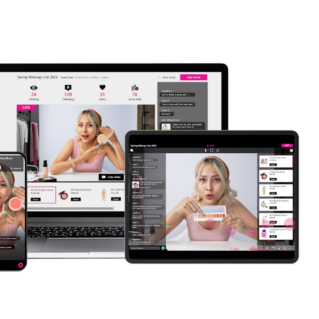Forget the industries, forget the products, what makes direct selling powerful is relationships.
The first being the relationship direct selling companies nurture with their representatives, one that enables entrepreneurship and provides the tools for them to succeed.
And the second; the one-on-one relationships that direct sellers maintain with their customers.
Personalization is at the very heart of direct selling. However, buying behavior is evolving, and that evolution is digital.
The Global B2C e-commerce turnover was $1.84 trillion last year, and two in five Americans learn about new brands and products from social media sites.
What this tells us is that it’s more important than ever that direct selling businesses not only establish a solid online presence but start to think long-term about how to leverage online and social channels in a creative way to boost awareness and provide digital tools for their direct sellers.
In some ways, this might seem at odds with the personal nature of direct selling, but a closer look at the numbers tells us that 70 percent of online shoppers are still more likely to buy a product recommended to them by peers, family or someone they trust.
Why? Because personal relationships still matter in digital spaces.
If that isn’t enough, consider this; digital natives like Millennials and Gen Z’s account for 38.3 percent of direct sellers. That’s more than Generation X’ers who make up 34 percent of direct sellers and Baby Boomers who make up 24.4 percent. And most of those Millennials, about 67 percent of them, prefer to shop online than in stores.
So, while refining online marketing efforts is more important than ever, how does that personal touch translate into digital spaces?
How Direct Selling Companies Can Be Personal In Digital Spaces
The marketing challenges that face direct selling companies are unique in that most brands are working to personalize an otherwise impersonal product.
Direct selling companies have the reverse issue. Since most direct sellers are evangelists for their brand already, having either used or sold the product for a long time, the trick for direct selling companies is scale. Bringing this innate personalization to a bigger audience. Both to more direct sellers, then in turn, making it easier for those direct sellers to appeal to customers.
And the key to making that happen is leveraging your website for data collection. When personalizing a site or shopping experience, there are several customer data points worth using to deliver contextually relevant content and products.
“2 in 5 Americans learn about new brands and products from social media sites.”
An obvious one is the Shopping Cart, of course. Recommending products to your shoppers based on what the customer has in their shopping cart.
Purchase History, which involves recommending or making customers aware of certain products based on their past purchases. Taken a step further, you could also use this data to build segments and then use purchase histories of customers with similar demographics to recommend other products.
By tapping into customers’ Search Queries, you can furthermore recommend products based on their search terms or use geo-location data to recommend products based on where your customer is shopping from. After all, the skincare regimen of someone living in the cooler climate of Nebraska will certainly differ from that of a person living in sun-blistered and humid Florida.
And by leveraging all these data points, the digital shopping experience that you deliver to your customers isn’t impersonal at all. It’s the opposite, because it’s tailored to that person’s preferences and needs.
Empowering Direct Sellers With Social Networking Tools
By now your website, online store and online catalog should already be accessible and responsive on mobile devices.
Given that 77 percent of Americans use smartphones and that shoppers who buy on smartphones spend on average twice as much as those who shop on other devices, it’s obvious that mobile commerce deserves your time.

Especially since only 12 percent of consumers find shopping on the mobile web convenient, meaning there’s much room to improve and capture sales.
By integrating your online catalogs with WhatsApp or Facebook Messenger, you both successfully track customer buying journeys and offer your direct sellers more touch points with their buyers.
Here’s how that might look. The customer and direct seller connect on WhatsApp or Facebook Messenger. Then, the customer browses through the online catalog on your site on their phones, adding to cart as they go. When they finish shopping, they click, connect to WhatsApp, select their representative and the shopping list is sent automatically.
This will instantly improve the experience your buyer has, because they can shop in their own time, wherever they’d like and still maintain a personal relationship with their direct sellers. It still feels like they’re being taken care of and have that connection to their representatives.
Get Personal With Your Content Strategy
Personalized content directly influences sales. One study suggested that companies that actively worked to customize their marketing content saw an average sales increase of 19 percent. That’s high, even a fraction of that is a success.
But of course, it requires some work, because it means offering customers more than a simple email telling them that a sale is on.
It means sending out personalized offers and contextually relevant blogs, videos or other content that might be of value to them.
You could even go so far as to trigger emails when certain products are purchased in tandem. For example, say a customer has selected a combination of melatonin tablets and vitamin D. An email with a link to a blog with tips and tricks to improving the quality of your sleep is a great way to provide aftercare at the end of a purchase. Fostering trust in your brand and increasing the likelihood of a repeat customer.
Much like the personalized website experience, you can target content based on location too or relevant search queries, so long as it relates to the specific customer and shows your company cares and pays attention. Something that, in principle, comes naturally to most direct selling companies and their sellers already.
When you get this right, it can incentivize customers and increase their purchases. That’s to say, provide a good enough experience, and they’ll keep coming back.
Sometimes Getting Personal Starts With Data
The cornerstone of personalizing any step in your customers’ journey—from discovery to purchase and to repeat purchase—is data collection.
When you think about it, it’s something direct selling companies and representatives are doing every day. They have a clear image of who their customers are, whether it’s general age, income, the type of person they are, what their pains are and how the products they offer might help solve those problems.
It’s just that, with the right infrastructure in place, by going digital the data collection is done for you.
Whether it’s figuring out who’s on your site, and how often, to seeing how many people read, interact or ordered from your catalogs, which direct sellers are most active, going digital offers more data points and gives you a clearer picture of how to build your success.
It seems like an investment of time and resources in the start because it is, but in the long term, the payoffs are undeniable.

Nanna Arnadottir
Nanna Árnadóttir is a Content Marketer at iPaper, a Danish SaaS company that focuses on helping businesses turn static PDF catalogs into inspirational online sales channels and shoppable content.



